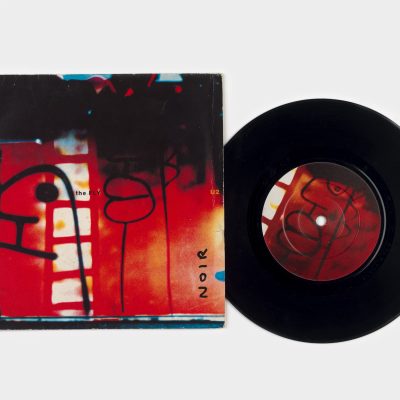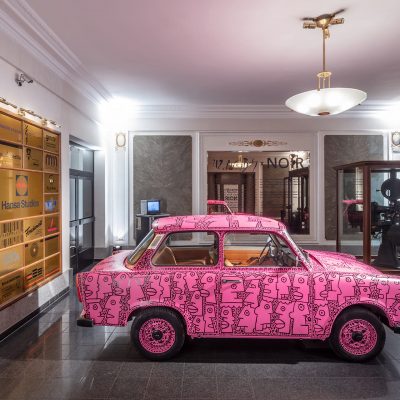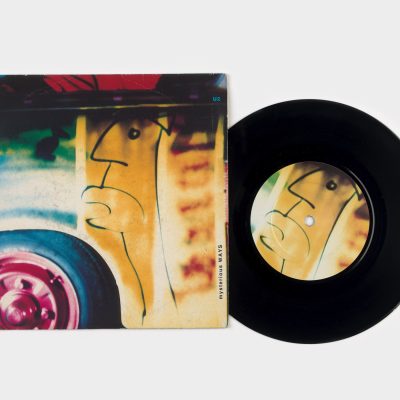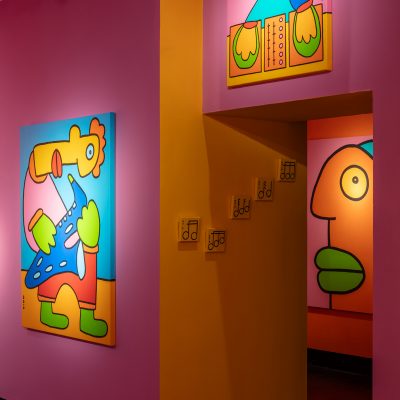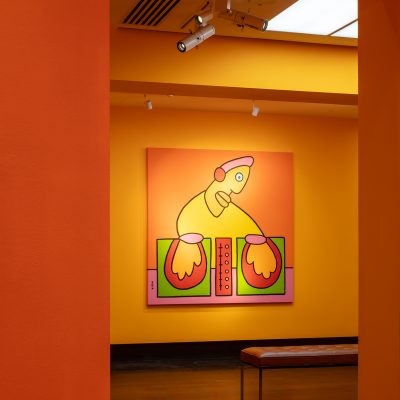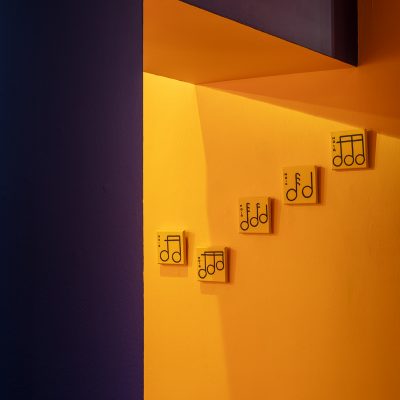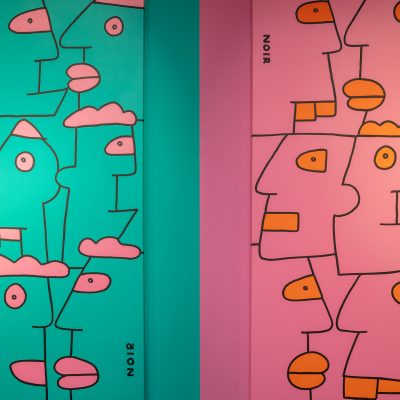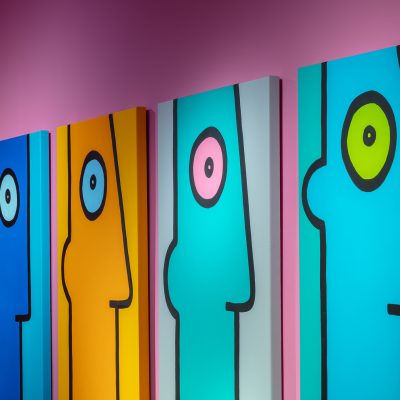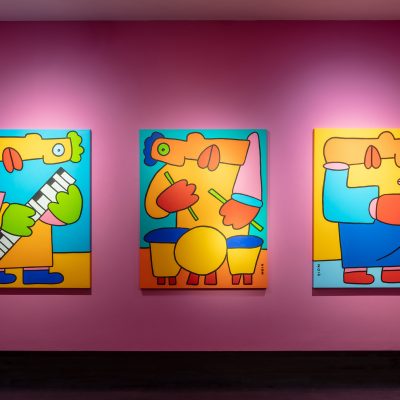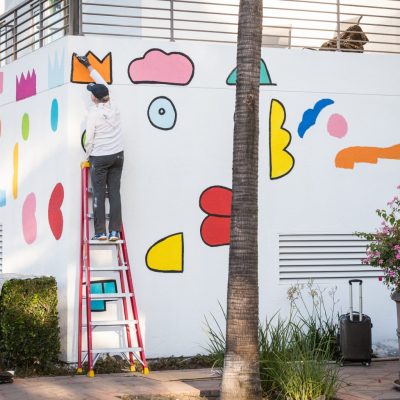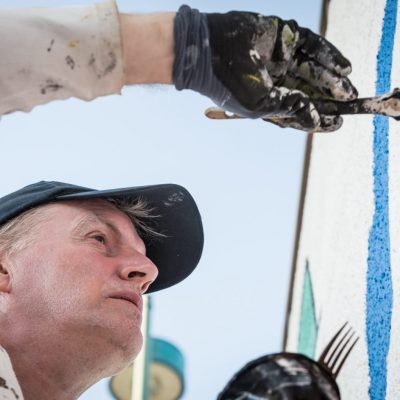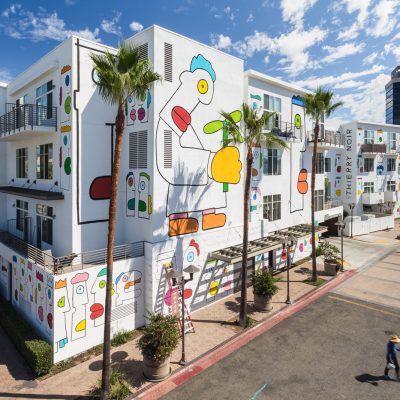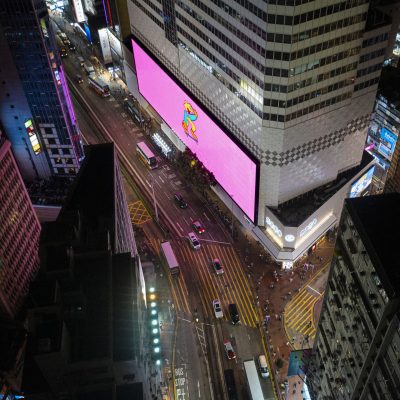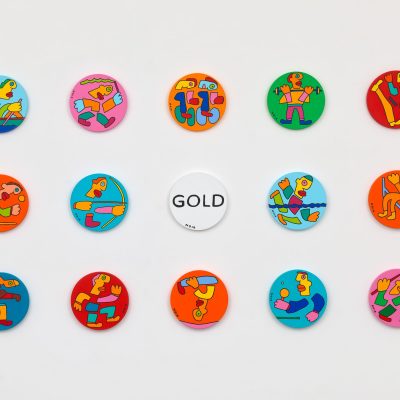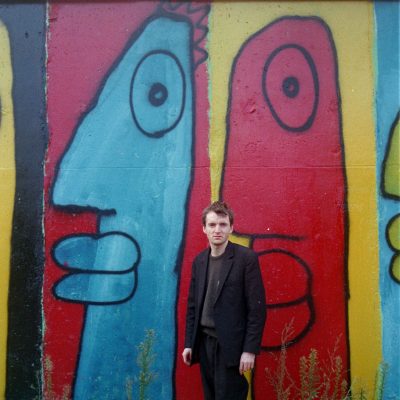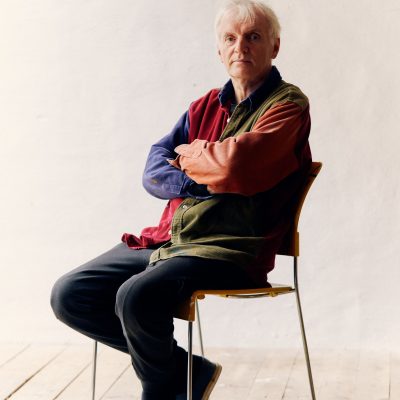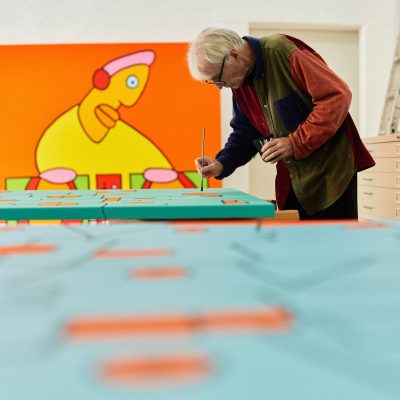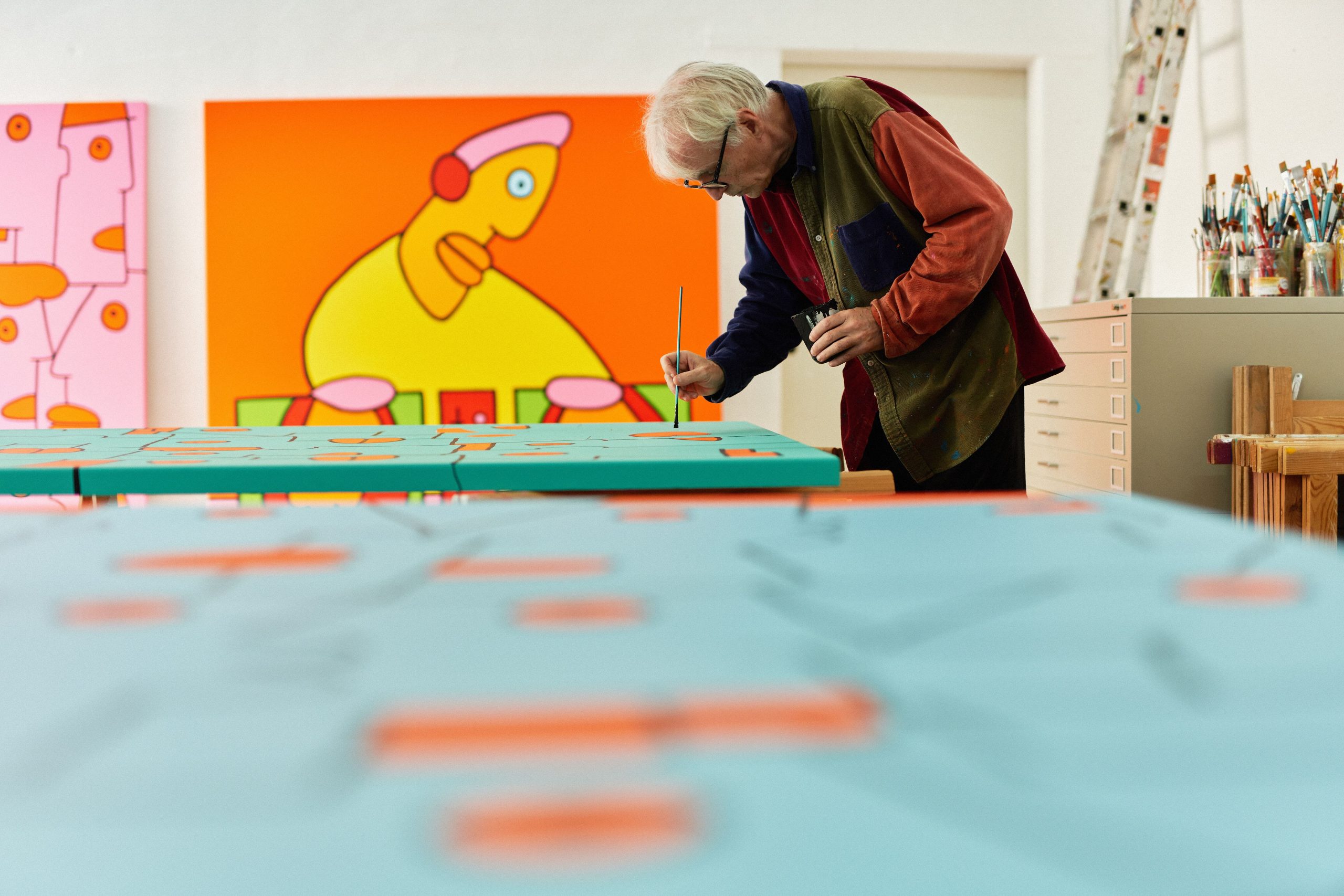
Two years ago, serendipity led me to discover the captivating world of Thierry Noir’s artwork at an esteemed auction house. Since then, I’ve been following his artistic journey. Noir’s oeuvre spans from the realm of mural art to canvas paintings that exude boundless energy and rhythmic music.
His artworks often feature anonymous figures with circular or elliptical eyes, set within geometric shapes. These enigmatic characters either inhabit their own distinct worlds with an air of disdainful detachment or engage in the joyous pursuit of playing musical instruments. Some figures even cast a cold, unflinching gaze upon the audience. It’s as if these figures are Noir himself, I can’t help but think, perhaps, in a way, Noir is painting himself. For those passionate about contemporary art, like myself, Noir’s work is profoundly alluring, not solely due to his bold and vivid visuals but also because of the artist’s unique story.
Thierry Noir, hailing from France, etched his name in history as the trailblazing artist who painted extensive murals on the Berlin Wall in the 1980s. This monumental structure divided East and West Berlin during a turbulent time. Noir’s murals, which used vibrant colours and simple, almost cartoon-like imagery, evolved into symbols of hope, defiance, unity, and longing for emancipation. They played an instrumental role in the eventual destruction of the Wall in 1989.
As we stepped into Noir’s exhibition at Christie’s this autumn, we were beckoned into a world that seamlessly transitions from concrete “walls” to expansive canvases. We were privileged to conduct an interview with Noir. His distinctive style, characterized by its bold and vibrant essence, remains as captivating as ever. He generously infuses his experiences, love for music, humour, innocence, and humility into his artistic expressions.
AZ: Let’s talk about the new Techno exhibition at Christie’s this time.
TN: The preparation for this exhibition began six months ago, and it involved the creation of entirely new artworks specifically for this event. It was a challenging six months of hard work to organize everything, from selecting the colours of the walls at Christie’s to preparing each of the canvases. The inspiration for this exhibition actually came from Fabric, a techno nightclub near Farringdon in London. About three or four years ago, I was invited to creat a mural inside the club. The idea for this exhibition had been brewing for a while, but when the pandemic hit, everything became much more challenging. Now, things are back to normal and people are partying again.
AZ: You have had many projects since your Berlin Wall creation. Is there a favourite? Which projects have left the deepest impression on you?
TN: The Techno project at Christie’s is a personal favourite of mine. It involved a collaboration with music and different musical styles and instruments. I also have vivid memories of the huge murals that I painted in Los Angeles in 2017 which are the largest in the city. I spent two months under the scorching sun of California. It was so hot that I had to constantly hydrate, drinking at least a gallon of water daily just to combat the immediate effects of sweating.
AZ: You were inspired by music of that time when you were painting on the Berlin Wall; how about now? Have you changed the music you listen to? How has it affected your creation if there’s any?
TN: I’d like to maintain the same feeling I had 40 years ago, the same approach. It’s crucial to preserve the spirit of that time, albeit in a different way, while maintaining the same quality of art and embracing the social element. When I’m painting, I don’t feel like I’m working; it’s a passion.
AZ: Have you noticed any changes?
TN: Yes, white hair now. (Laughs)
AZ: Did you change your music style a little bit?
TN: As for my music taste, it has evolved somewhat. While painting, I used to listen to the radio, but whenever advertisements came on, I’d swiftly switch to another channel. Most of the time, my musical choices still harken back to the ’80s and ’90s. Artists like Depeche Mode, Pet Shop Boys, David Bowie and Human League make up my playlist.
AZ: Project Achtung Baby 30 was a collaboration with U2 to mark 30 years since the release of Achtung Baby. How did the collaboration with U2 happen? Do you also listen to U2’s music? Any interesting stories to share from the collaboration? In 1991, you had already created a series of painted 601 Trabants for U2, and the Noir Trabants and artwork were featured on the cover of their album. Therefore, in the second collaboration, do you feel your thoughts or feelings have changed somewhat? What are your new reflections, if any?
TN: U2 made a significant record when the Berlin Wall fell, aptly titled Achtung Baby. In 1991, U2 ventured into film by contributing music to a movie called Until the End of the World directed by Wim Wenders. Then for their Achtung Baby project the band sought out the artist who had painted the Berlin Wall, me. My art had been featured in Wim Wenders’ Wings of Desire in 1987 and it was Wenders who made the original connection between myself and U2. So in 1991, I painted 15 Trabants which were used for U2’s Zoo TV World Tour. One Trabant also featured on the album cover of the original Achtung Baby LP. Thirty years later, I was invited by U2 to create a new Trabant. It was exhibited inside the entrance of the renowned Hansa studio in Berlin which was where Achtung Baby was originally recorded.
AZ: Project GOLD is an ambitious project showcased in 10 countries. What inspired this project?
TN: GOLD was initiated in Tokyo to celebrate the 2020 Olympics. I created artwork for each sporting disciple featured in the Summer Olympics. Each painting was on a 40-centimetre diameter round canvas, somewhat resembling a hidden treasure. After creating the canvases, I also created moving animations of the sports and these were projected onto monumental digital screens in various cities around the world, including Tokyo, Seoul, Hong Kong, Shanghai, New York and London.
AZ: When painting the Berlin Wall, you risked your life. What were your feelings at that time?
TN: Painting on the Berlin Wall was strictly prohibited. The Wall wasn’t just a border; it represented a zone. The actual West-East border was five metres behind it. So, when I painted the Berlin Wall, I was technically inside East Berlin. Both sides of the war, including the soldiers, were within East Berlin. Occasionally, soldiers would come over. It happened once, and when they approached, they brought a ladder and machine guns. However, they were only about five metres away, so it was relatively easy to run. The trick was not waiting for them to get too close.
As for the feeling, it was incredibly bizarre. It felt like a leftover, a piece of something unusual. This incident took place when we were trying to create something special for a television segment at 6 in the morning. They arrived with television lights, huge ones. But since it was still early, between day and night, the intense light made everything look particularly extraordinary, as if the gods were trying to communicate something. So, we started drilling with a machine or attempting to attach a door to the wall. They approached me, and one soldier even stood over me. The television was urging us to stop, fearing the situation was becoming too dangerous. They eventually left.
Afterward, we witnessed many cars and trucks. People were on the phone, and then four soldiers came and took away what we had tried to attach—a heavy metal door with a metal frame. Imagine a door that’s around three metres and sixty centimetres tall, and they had to carry it. As they leaned it against the wall, there was a colossal sound, and they took the door away. It was always something special, dramatic, and intense.
It was far from being just an art project. Remember, the Wall marked a deadly border. So, it wasn’t a lighthearted endeavour by any means. Reactions came from both the West and the East, and it was a serious matter for everyone involved.
Next year, it will mark 40 years since I first painted the Berlin Wall, but I don’t have any specific celebration planned. The places where I used to paint are no longer there. The Wall has vanished, and the abandoned streets have been transformed into well-renovated areas.
AZ: And you used to risk your life to do that.
TN: Certainly, yes. When I was young, I was full of energy and enthusiasm. The experience of painting on the Berlin Wall was truly unique. It was then that I realized that some people wanted to own a piece of my art, to bring my paintings to life for them. It was a significant moment in my career.
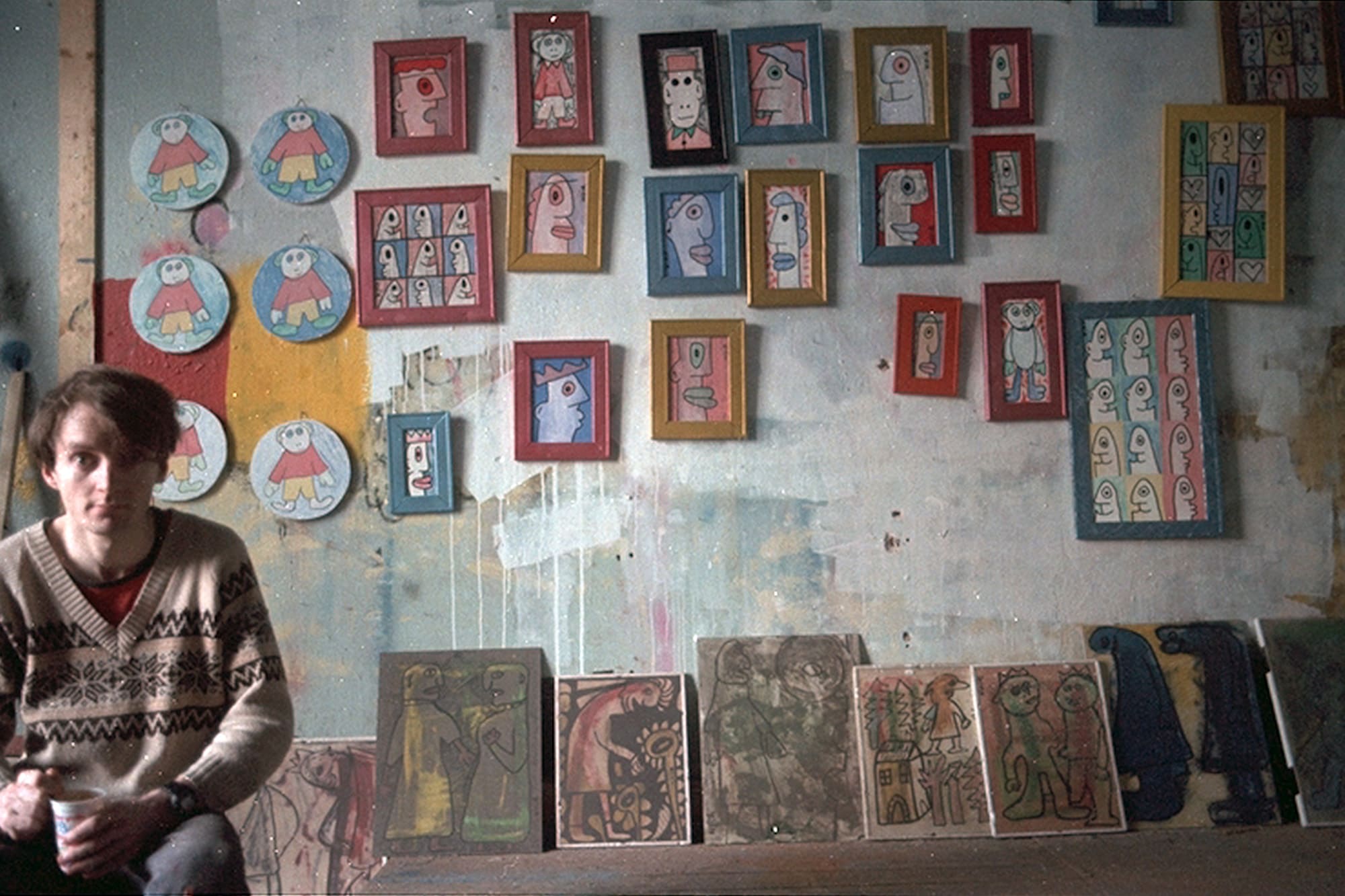
Thierry Noir at his studio in the Georg von Rauch-Haus opposite the Berlin Wall (1987) Courtesy of Thierry Noir Studio
AZ: How do you approach painting on canvas these days?
TN: I strive to maintain the same energy and enthusiasm as I did in the past. It’s about preserving that spirit without a guy with a machine gun behind me.
AZ: How does it feel now? Is it calmer, perhaps even somewhat therapeutic?
TN: It’s a different kind of feeling, one that keeps me in the creative mood, allowing me to reflect on my artistic journey—what I started and what I aspire to create next.
AZ: Could you tell us more about your “recipe” of two ideas and three colours?
TN: Certainly, this “recipe” emerged from the desire to address the initial apprehension that often accompanies painting. When you’re just starting, it’s natural to feel uncertain, and the expense of art materials can make you cautious about creating something you might not like. So, this “recipe” was conceived to empower people and give them the confidence to commence their artistic journey. It’s quite simple: take two ideas, such as a duality like good and bad, and combine them with three essential colours – green, red, and black. Blend these elements, and your painting is complete. This juxtaposition of two contrasting ideas adds a layer of depth and intrigue. It’s a playful concept, yet we hope it resonates with those who are truly passionate about their art.
AZ: Any new projects coming up to share? Will there be more projects in Asia?
TN: Yes. Next year in Hong Kong, probably.
AZ: If you could paint on any walls in the world, where would it be? Why?
TN: I believe it’s essential not to confine myself to a wall for the rest of my life, but rather, to leave it for the younger generation to shape and define with their artistic expressions.
AZ: Do you have any words of advice for emerging artists in the new generation?
TN: I would say that finding your unique path is crucial. Avoid simply following in someone else’s footsteps, as imitation won’t lead to a lasting legacy. Strive to be original. If you can create a distinctive style that sets you apart, people will come to appreciate the value of the original over time, choosing it over mere imitations.
AZ: What do you like to do when you’re not creating art?
TN: I enjoy strolling around, observing life. Places like Covent Garden in London are fascinating to me; it’s an excellent spot for people-watching.
AZ: Will you retire one day?
TN: I don’t know.
專訪特里·諾爾——繪制一個打破想象力邊界的世界
兩年前一次偶然的機會,我在一家聲譽卓著的拍賣行遇見了特里·諾爾(Thierry Noir)的作品,那鮮豔的色彩、簡化的形象和強烈的視覺效果深深觸動了我。從那一刻起,我便一直追蹤他的創作軌跡。諾爾的藝術不僅限於壁畫,他還創作了一系列布面油畫,這些畫作不僅充滿了無盡的活力,更是節奏和音樂性的視覺化展現。
諾爾的作品裡經常展現各式匿名人物,他們以圓形或橢圓形的眼睛為特徵,被巧妙地安置在簡約的幾何形狀之中。這些神秘的角色看起來要麼帶著冷漠的疏離感獨自存在,要麼沉浸在演奏樂器的歡樂之中。有些作品中的人物甚至向觀眾投來冷冷的凝視。我禁不住想,這些人物是不是就是藝術家自身的投射呢?也許,在某種程度上,諾爾畫的正是自己。對於像我這樣對當代藝術充滿熱情的藝術愛好者來說,諾爾的作品深深吸引著我,不僅因為他大膽鮮明的視覺效果,還因為這位藝術家獨特的故事。
特里·諾爾,這位來自法國的藝術家,於1980年代在柏林牆上創作了大量的壁畫,成為歷史上首批在該牆留下痕跡的藝術家之一。柏林牆,這座在動蕩時期象徵性地分隔了東西柏林的建築結構,成為了他最初創作的畫布。諾爾利用明亮的色彩和簡潔、近似卡通的圖像,將其作品轉化為希望、抗爭、團結以及對解放的渴望的象徵。這些壁畫在1989年柏林牆的倒塌過程中扮演了一個關鍵的角色。
今年秋天,當踏進倫敦佳士得為諾爾舉辦的《電音》展覽時,我彷彿進入了一個奇幻的藝術世界,牆壁與畫布之間的界線被巧妙地模糊了。我們有幸與諾爾進行了深入的交流。他的「牆壁」作品無縫地過渡到畫布之中,那標誌性的、充滿活力的色彩風格依然令人著迷。諾爾慷慨地分享了他的經歷和對音樂的喜愛,他的幽默、純真和謙卑融入到作品之中,使他的藝術充滿了獨特的魅力和深意。
AZ:您可以談談這次在佳士得拍賣行舉辦的展覽《電音》嗎?
TN:這次展覽的籌備工作始於六個月前,我為這次展覽專門創作了全新的藝術作品。這是六個月辛勤工作的結果,我仔細挑選了展覽空間的牆面顏色,準備了與之相配的每一塊畫布。這次展覽的靈感實際上來自於倫敦Farringdon附近的電子音樂俱樂部「Fabric」。大約三四年前,我受邀在俱樂部內創作一面壁畫。這次展覽的想法已經醖釀一段時間了,但疫情的爆發讓一切變得更加困難。現在一切恢復正常,人們又開始相聚派對了。這次展覽對我而言,不僅是對過去六個月努力的展示,也是慶祝生活和藝術的重啟。
AZ:自從您在柏林牆上創作以來,您已經完成了許多不同的藝術項目。有沒有個人最喜歡的?哪些項目給您留下了最深刻的印象?
TN:這次佳士得的《電音》項目是我個人最喜歡的,它涉及到與音樂以及不同的音樂風格和樂器的結合。還有就是2017年我在洛杉磯繪制的大型壁畫,我在加州的烈日下度過了兩個月,現在回想起來那感覺還是歷歷在目。那裡的天氣非常炎熱,我不得不補充大量水分,每天至少喝上一加侖水來對抗流汗帶來的直接影響。這個項目確實印象深刻。
AZ:當年您在柏林牆上創作時您曾提到是受到了當時音樂的啓發,那麼現在呢?這些年來您的音樂品味有沒有改變?如果有,這對您的創作有什麼影響嗎?
TN:我希望保持我40年前的那種感覺,努力用相同的思考方式來創作。保持那個時代的精神是非常重要的。雖然創作方式可能有所不同,但我依然追求同樣的藝術質量,並且積極融入社會元素。當我創作的時候,我不覺得我在工作,我覺得是藝術激情令我去創作,而那時在柏林牆的創作,我覺得是一種使命。
AZ:現在有什麼變化嗎?
TN:有的,現在有白頭髮了(笑)。
AZ:您聽的音樂風格有發生改變嗎?
TN:我的音樂品味確實有所發展。以前畫畫時我經常聽收音機,但一有廣告我就會馬上換台。大多數時候,我的音樂選擇仍然還是回歸到80年代和90年代。像Depeche Mode、Pet Shop Boys、David Bowie、The Human League,這些是我主要的播放列表。
AZ:您與U2合作的《Achtung Baby 30》是為了慶祝《Achtung Baby》專輯發行30週年。能談談這次合作的緣起嗎?您平時也聽U2的音樂嗎?合作過程中有沒有什麼有趣的故事?回想1991年,您為U2塗鴉了一系列的601 Trabant汽車,這些作品甚至出現在他們的專輯封面上。那麼在這次第二次合作中,您有什麼新想法嗎?
TN:U2在柏林牆倒塌時發行了一張標誌性專輯《Achtung Baby》。1991年,他們為溫·文德斯導演的電影《直到世界盡頭》創作音樂,開始涉足電影領域。在《Achtung Baby》項目中,樂隊特別找到了曾在柏林牆上留下畫作的我,因為我的作品曾在1987年文德斯的《慾望之翼》中展現過,所以可以說是文德斯讓我與U2結緣。我為U2的《Zoo TV》世界巡演繪製了15輛Trabant(衛星牌汽車,前東德最具代表性的國民汽車),其中一輛還出現在《Achtung Baby》原版LP專輯封面上。三十年後,U2再次邀請我創作了一輛新的Trabant,這輛車在柏林著名的Hansa漢莎錄音室的入口處展出,這也是《Achtung Baby》專輯的誕生地。
AZ:您的《GOLD》是一個雄心勃勃的藝術項目,曾在10個國家進行過展示,能分享一下是什麼啓發了這個項目的呢?
TN:《GOLD》這個項目始於東京,是為了慶祝2020年的東京奧運會。我為夏季奧運會中的每個體育項目創作了藝術作品,每幅作品都是在直徑40釐米的圓形畫布上繪製的,形狀看起來像是被埋起來的珍寶。這些畫布作品完成後我還將它們轉為展示該項體育運動的動畫,並在全球多個城市的巨型數字屏幕上進行了展示,包括東京、首爾、香港、上海、紐約和倫敦。
AZ:當年在柏林牆上作畫,那似乎是一場與死神擦肩而過的冒險,您當時是怎麼想的呢?
TN:在柏林牆上作畫是被嚴格禁止的。那堵牆不僅僅是一道邊界,它還象徵著一個特殊的區域。事實上,真正的東西邊界還在牆的五米外。所以當我在柏林牆上作畫時,技術上來說我是處在東柏林境內的。戰爭的雙方,包括東德和西德的士兵們其實都在東柏林。那裡偶爾會有士兵過來。我記得有一次當他們過來時,他們帶著梯子和機關槍。但他們離我有大約五米遠,所以逃跑還是相對容易的。重點還是不要等他們靠得太近。
至於感受,那真是太奇特了。有一次印象特別深刻,那是發生在我們為一個電視節目創作特別內容時,大清早6點。電視台的人帶來了巨大的電視燈。但因為還很早,處於白天和黑夜之間,電視燈發出那些強烈的光讓一切看起來顯得格外神奇,就像是神來了要給我們傳遞信息。我們試著用機器在牆上鑽孔並安裝一扇門。這時有士兵向我們走來,甚至有一名士兵站在我上方。電視台的人敦促我們停下,怕情況變得太危險。後來士兵們離開了。
接著,我們看到許多車輛和卡車開來。先是有人在打電話,然後有四名士兵過來把我們試圖安裝的那扇笨重的金屬門拿走了。想象一下,那是一扇高達三米六的大門,他們不得不扛著。他們把門靠在牆上的時候發出了巨大的響聲,整個場地都震動了。最後他們把門就這麼扛走了。那是一個特別的、充滿戲劇張力和驚心動魄的經歷。
在我看來,在柏林牆畫畫這件事遠遠超出了藝術項目的範疇。別忘了,那堵牆代表著生死邊界。所以這絕不是一個輕鬆的實驗創作。無論是東德還是西德的人都在盯著,對於所有參與者來說都是一件嚴肅的事。
明年將迎來我在柏林牆上首次作畫40周年紀念,但我目前並沒有特別的慶祝計劃。我曾經作畫的地方已經不見了,那堵曾經的隔離牆已不復存在,昔日被遺棄的街區現在也變成了精心翻新的區域。
AZ:當年您曾冒著生命危險去作畫。
TN:確實如此。那時我還年輕,充滿了活力和熱情。在柏林牆上繪畫是真的獨一無二的經歷。那時我意識到有人想要擁有我的作品,希望把我的作品帶進他們的生活裡。這對我的職業生涯來說是一個重要的轉折點。
AZ:現在您是怎麼看待在畫布上繪畫的?
TN:我仍努力維持當年的那股熱情和活力,只是現在背後不會有個拿著機關槍的人(笑)。
AZ:現在是什麼感覺?會不會更平靜了,甚至有點治癒?
TN:現在是一種不同的感覺,一種敦促我繼續保持創意的感覺,讓我反思我的藝術之旅——我從何處開始,以及接下來我希望創造的是什麼。
AZ:可以跟我們詳細講講你的「兩個理念,三種顏色」的創作方程式嗎?
TN:這個「方程式」源於解決繪畫初期常見的疑慮。當剛開始繪畫的時候,感到不確定是很自然的,而且藝術材料的成本可能會讓你在創作一件可能不喜歡的東西時變得謹慎。這個「方程式」旨在賦予人們力量,並給予他們開始藝術之旅的信心。方法很簡單:選擇兩個理念,例如善與惡這樣的二元對立,然後結合三種基本顏色——綠色、紅色和黑色。將這些元素結合在一起,你的創作就完成了。這種兩種對立理念的並置增加了作品的深度和趣味。這是個俏皮的概念,但我希望它能與那些真正熱愛藝術的人產生共鳴。
AZ:未來有什麼新項目可以透露嗎?
TN:嗯,可能明年在香港,還在計劃之中。
AZ:如果您能在世界上任何一堵牆上畫畫,你會選擇哪裡?為什麼?
TN:我認為重要的是不能一輩子被「牆」所局限,我覺得應該留給年輕一代,讓他們用自己的藝術表達來重新塑造和定義。
AZ:您對年輕一代的藝術家有什麼建議嗎?
TN:我會說,找到自己的道路是很重要的。避免跟隨別人的腳步,因為模仿不會帶來長久流傳的作品。努力做到原創。如果你能創造出自己獨特的風格,讓自己與眾不同,隨著時間的推移人們會逐渐欣賞到原創的價值,會選擇你而不是僅僅滿足於模仿品。
AZ:您不創作藝術的時候喜歡做什麼?
TN:我喜歡四處漫步,觀察生活。像倫敦的考文特花園這樣的地方對我來說很有迷人,這是觀察人們的絕佳地點。
AZ:您會有退休的一天嗎?
TN:我還不知道(笑)。
Interviewed 採訪 x Rinka Fan
Edited 編輯 x Michelle 余小悅

